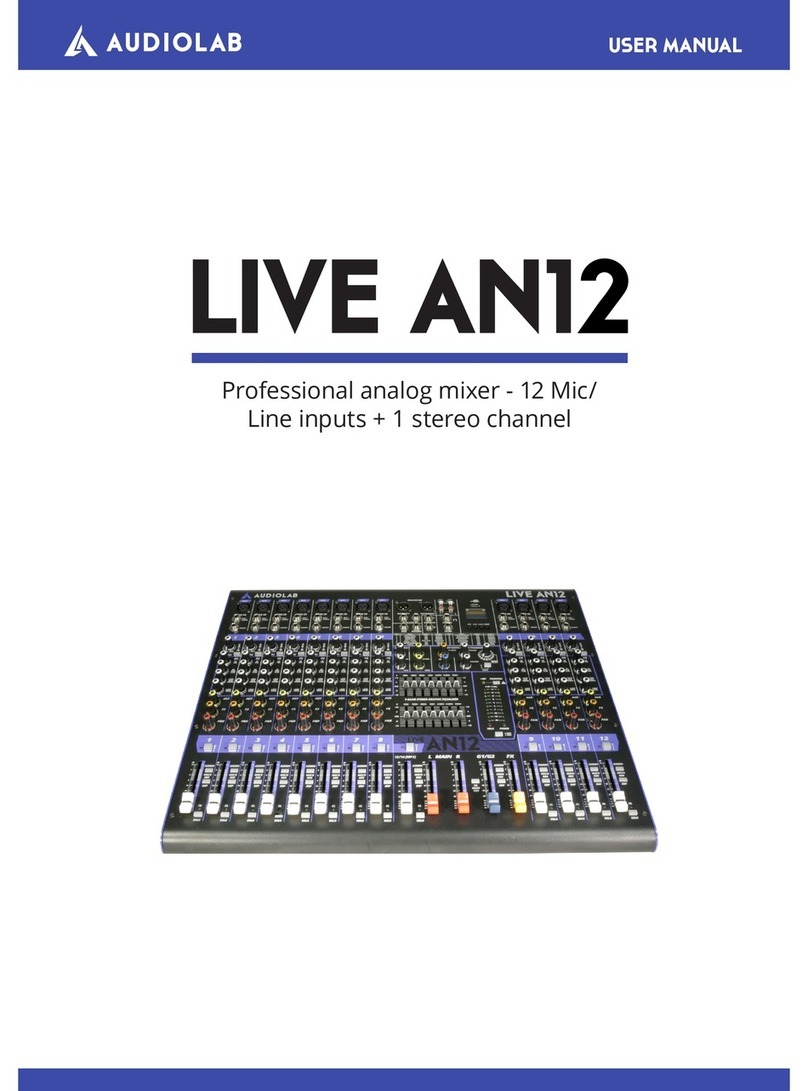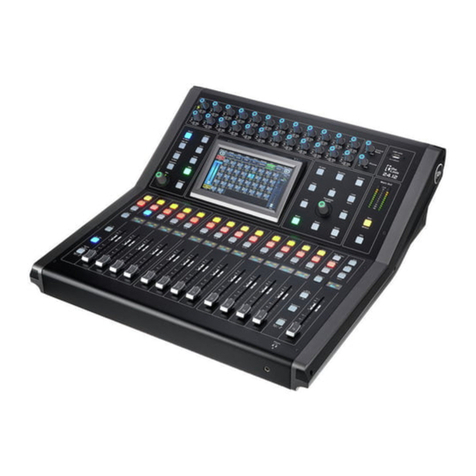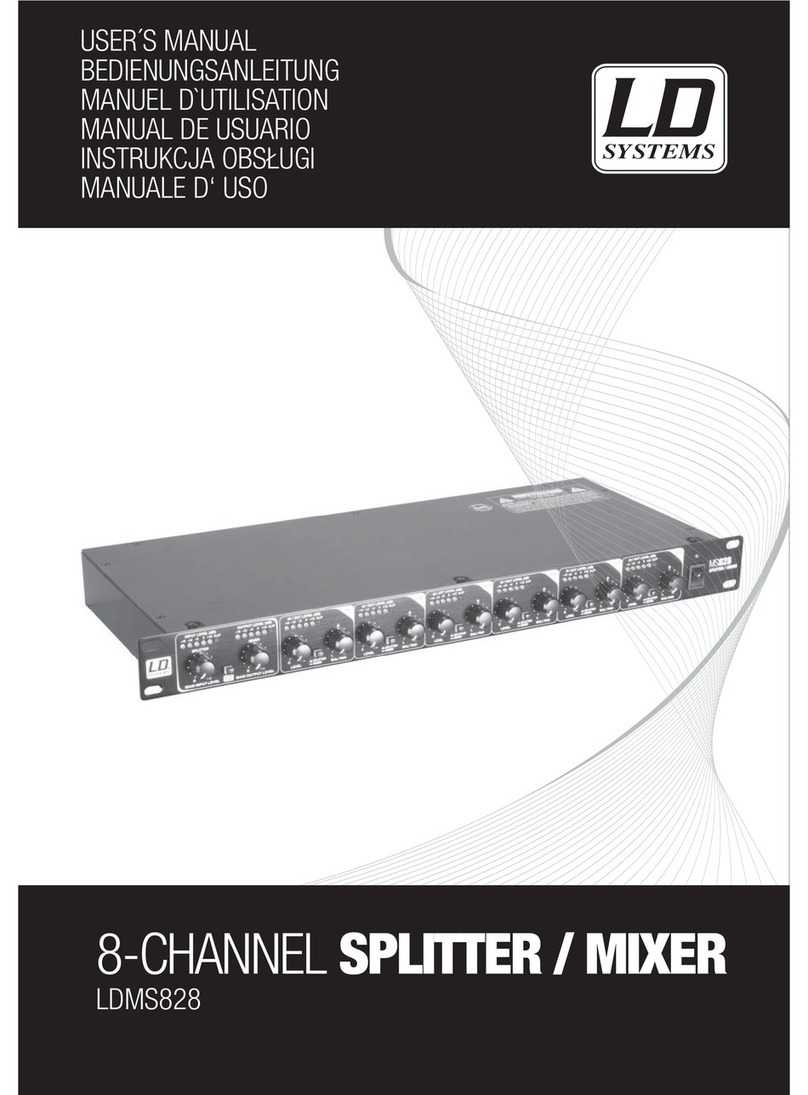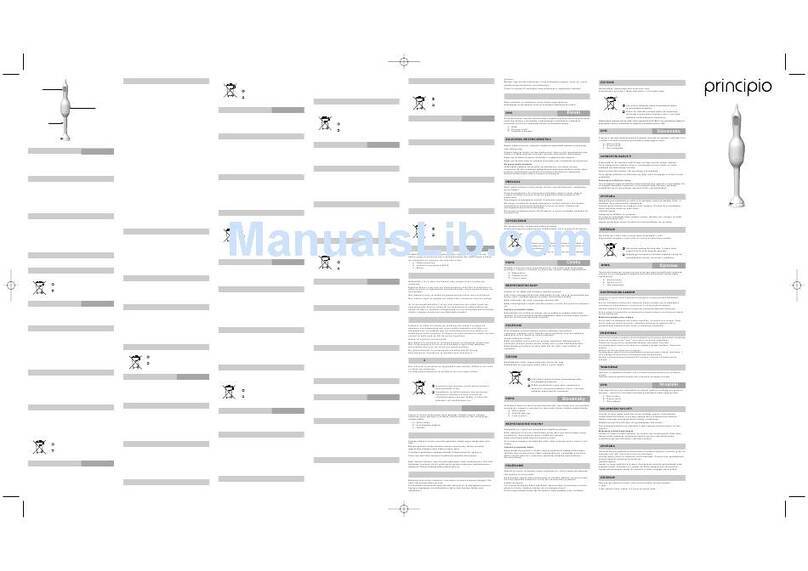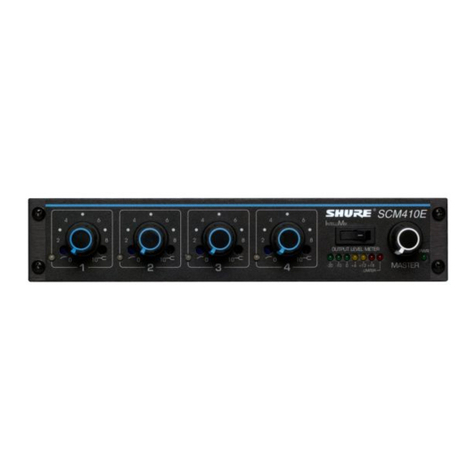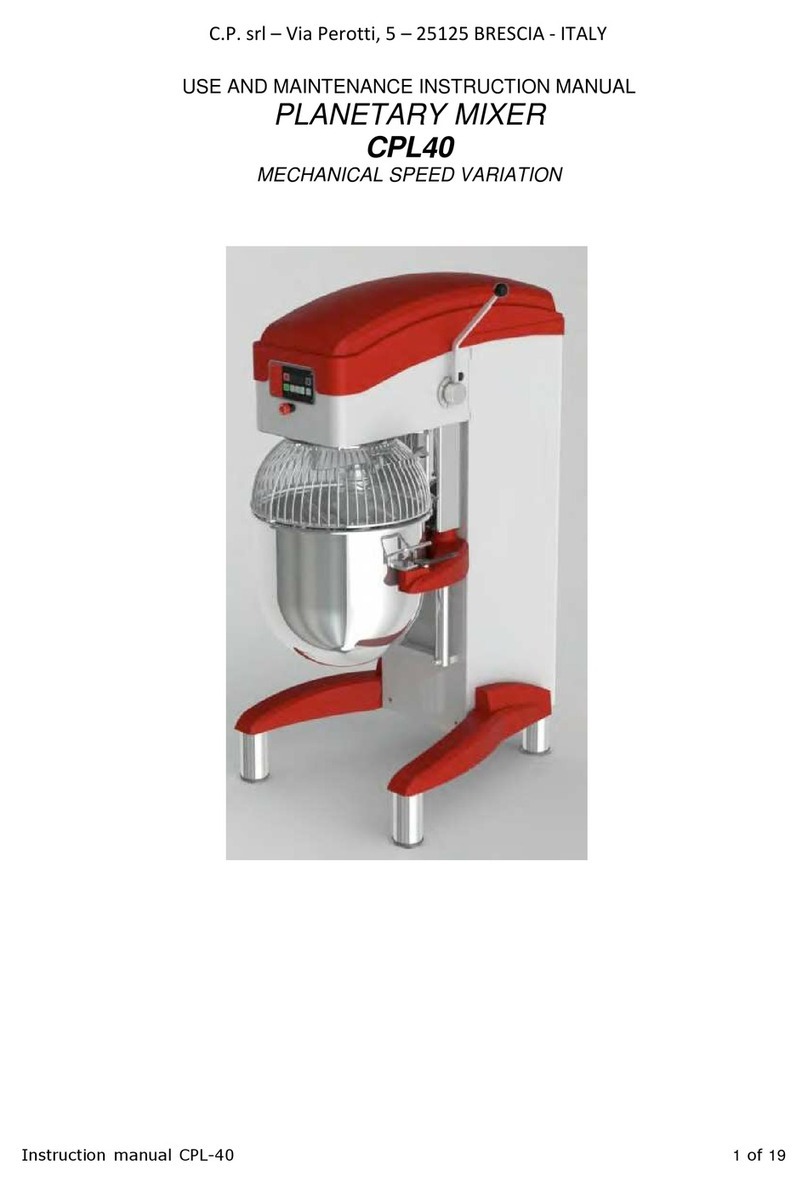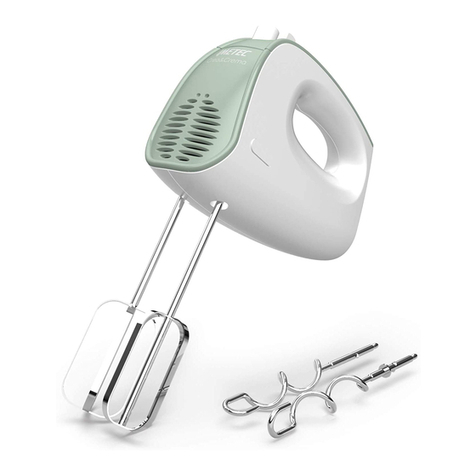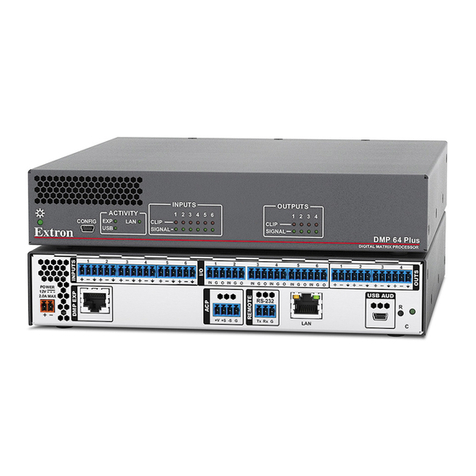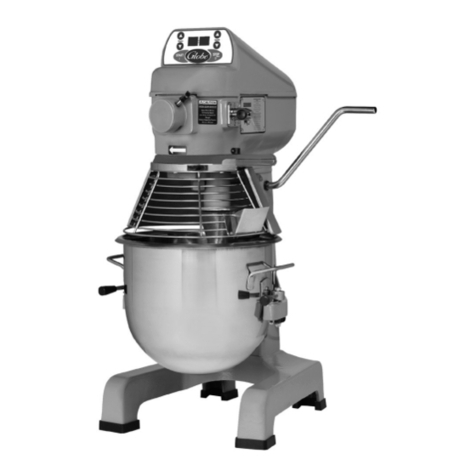Audiolab LIVE AN8 User manual

P. 1
- AUDIOLAB LIVE AN8
LIVE AN8
Professional analog mixer - 8 Mic/
Line inputs + 1 stereo channel
USER MANUAL

P. 2
AUDIOLAB LIVE AN8 -
Live AN8
Professional analog mixer - 8 Mic/Line inputs + 1
stereo channel
Live AN8 is an ultra-compact professional analog
mixer that features 8 Mic/line inputs with balanced
XLR/TRS connectors, 1 stereo channel and 2 sub-
groups. Thanks to its very low noise preampliers,
the entire Live AN series works with a very trans-
parent sound and also incorporates a 24-bit DSP
FX processor with 16 programs. Live AN8 sports a
4-band equalization in all mono channels to work
the signal in a professional manner and features a
Low Cut button per channel, to attenuate (-18dB)
signals below 75Hz. A 7-band stereo graphic
equalizer, 1 auxiliary output, 2 group outputs and
an MP3 player with USB port are amongst the
most outstanding features of the Live AN series, a
series designed for applications that do not require
a large number of channels but demand an out-
standing sonorous delity.
Specications
General
• Mono Channels: 8
• Stereo Channels: 1
• Subgroups: 2
• Output connectors: 2 XLR & 2 TRS 1/4" Jacks
• Maximum levels: Mic: 30dBu / Line: 21dBu /
Stereo: 22dBu
• Input sensitivity: Mic: -60dB / Stereo:-40dB /
FX Send/Return:-20dB
• THD: <0.007%, +4 dBu @ 1KHz, unity gain
• Gain Control: -60dB~-20dB
• Input impedance:
- Mic: 4.7Ohm
- Line: >10KOhm
• Crosstalk: <-82dBu
• Earphone output power: 500-800mW
• Output impedance: < 120-Ohm
• Signal-to-Noise ratio: -80dB
• Frequency Response // Mic Input to main
output: +0,-1 dB, <10Hz to 80kHz; +0,-3 dB,
<10Hz to 120kHz
• Max output level: 22dBu
• 2 x 7 graphic equalizer
• +48V phantom power
• 1 auxiliar output
• 2 group outputs
• 24-bit digital FX with 16 programs
• MP3 player with USB port
Per channel
• Mic Input: Electronically balanced XLR
• Line Input: TRS 1/4" Jack
• Insert: TRS 1/4" Jack
• Stereo inputs: 2 RCA
• Equalization - mono:
- HF: 12KHz ± 15dB
- HMF: 2.5KHz ± 15dB
- LMF: 400Hz ± 15dB
- LF: 80Hz ± 15dB
• Equalization - stereo:
- HF: 12KHz ± 15dB
- LF: 80Hz ± 15dB
• Low-noise preamplier with strong anti-jam-
ming power
• Mute and solo selector
• Main mix and group selector
• Low Cut (75Hz)
• Peak indicator
Physical
• Dimensions: 415x475x135 mm. /
16.3x18.7x5.3 in.
• Weight: 6.8 Kg. / 15 Lbs
1. OVERVIEW
English version

P. 3
- AUDIOLAB LIVE AN8
11. Pan
The pan control sends comtinuosly variable
amounts of the post fader signal to either the left
or right main busses. In the center position equal
amounts of signal are sent to the left and right
busses.
12. Mute
All output from the channel are enabled when the
MUTE switch released and muted when the switch
is down.
13. Channel Fader
This is function to adjust the volume of signal con-
nection in to each channel and adjust the volume
of output, together with master fader. Normal
operation is at the O mark, providing 4dB of gain
English version
2. INPUT CHANNEL SECTION
1. Balance Input
Electronically Balanced inputs acceptable a stand-
ard XLR male connector. +48V Phantom Power
available on each input Mic socket. And this switch
is on Rear Phantom Power.
2. Line Input
The unbalanced Mic input is provided for the use
of a unbalanced mic and is designed to accept a
unbalanced high impedance input signal (This use
for connection Deck, Turntable, Keyboardect.)
3. Insert
The INSERT is a break point in the input channel
signal path. It allows the signal to be taken out from
the mixer, through an external equipment such as
a compressor, and then back to the mixer to contin-
ue the nal mix output.
4. Gain control
Adjusts input sensitivity from -60dB to -20dB with
the -20dB pad switch in the out position, and -40dB
to 0dB when the -20dB pad switch is pushed.
5.Low cut
The LOW CUT switch, 75Hz at a rate of 18dB per
octave.
6/7/8. 4-Band Fixed -
Frequency EQ
The stereo channels (9-16) have a 4-band xed
- frequency equalization: LOW shelving at 80Hz,
LOW MlD peaking at 400Hz, HIMID peaking at 2.5kl-
lz, and Hl shelving at 12kHz. Each of these lters
provides up to 15dB of boost or cut. As with the
mono channels the circuit is at (no boost or cut)
at the center detent positions.
9. AUX Send
Use this control to set the level of signal from ex-
ternal stereo source and the main signal control
is re controlled by STEREO or MONO section.
10. EFF
Use this control when you want to get eect
sound by adjustment of input signal. When
youdont use external source, digital delay will be
working which installed inside.

P. 4
AUDIOLAB LIVE AN8 - English version
1
2
3
4
5
6
7
8
9
10
11
12
13
15.1
15
14

P. 5
- AUDIOLAB LIVE AN8
English version
above that point, if required.
14. OL (peak level indicator)
A red LED indicates a signal level at the insert
return point, pre master fader, It illuminates at
approximately 5dB below clipping.
15. Solo
This lovable switch allows you to hear signals
through your head phones or control room with-
out having to route them to the main mix. You
dont even have to have the channels fader turned
up. Folks use solo in live work to preview channels
before they are letin to the mix, or to just check
out what a particular channel is up to any time
during a session. You can solo as many channels
at a time as you like.
15.1. Group and Main Mix
Assign Switches
Alongside each channel fader are three buttons
referred as channel assignment switches, used in
conjunction with the channels PAN knob, they are
use to determine the destination of the channels
signal.
With the PAN knobat the center detent, the
left and right sides receive equal signal levels
(GROUPS 1-2, and MAIN MIXL - R). To feed only one
side or the other, turn the PAN knod accordingly.
If you are doing a mix down to a 2-track, for exam-
ple, simply engage the MAIN MIX switch on each
channel that you want to hear, and they will be
sent to the MAIN MIX bus. If you want to create a
sub group of certain channels, engage either the
1-2 switches in stead of the MAIN MIX, and they
will be sent to the appropriate Group faders. From
there, the groups can be sent back to the MAIN
MIX (using the MAIN MIX assign switches next to
the Group fasers), allowing you to use the Group
faders as a master control for those channels. If
you recreating new tracks or bouncing exist-
ing ones, you will also use the GROUP ASSING
switches, but not the MAIN MIX switch. Here,
you dont want the sub groups sent back in to
the MAIN MIX bus, but sent out, via the GROUP
OUTS jacks, to your multitrack inputs.

P. 6
AUDIOLAB LIVE AN8 - English version
3. MASTER SECTION
16. Stereo Graphic Equalizer
2X7-band equalizer is provided for tone control
over each frequency, and for precise high quality
sound by nal tone control.
17. Phantom Power Switch/LED
Depressing this switch applies 48VDC across all
microphone input channels connectors for remote
powering of condenser microphones. The LED will
be runed on when phantom power start working.
18. Outputs Level Indicator
Condition on the way of operation. Therefore, you
can see output condition thru this master level
indication.
19. Power LED
The POWER LED will be turned on when start
working.
19.1. Main to Mon Switch
This switch routes the stereo L/R Main Mix and
DROUP signal to both the Monitor and Phones
outputs when there are no solo switches engaged.
The L/R Main Mix signal is overridden in the Mon-
itor and Phones out puts by any PFL solo. NOTE:
If a PFL solo switch is engaged, including Main To
Mon/Phones.
20. FX Level
Using by this control, you can adjust signal level of
echo repeat & exterior eect.
21. Output Main Fader
This is a master fader for adjustment for volume
of left/right output. Unity gain is the top their
travel.
22. 9/10 VOLUME
Using by this control, you can adjust signal level
of 9/10(mp3).
23. HI(high)
You can adjust of 9/10 channel. See the "6.HIGH".
24. Low
You can adjust of 9/10 channel. See the "8.LOW".
25. Aux Return
This is used of adjusting volume of echo AUX
sound. When return AUX singal to used jack.
17
18
19
19.1
16

P. 7
- AUDIOLAB LIVE AN8
English version
26. Aux send
When this button is up, Post signal work as send
signal. When this button is down, post signal work
as eect singal.
27. FX Send
This is used for adjusting volume of echo fx
sound, when sending echo sound to send jack in
eect panel.
28. Phone
This is a single volume control sends the level to
the headphones and main monitors.
29. Eects Control
This is a 24BIT digital eects processor control.
30. Eect Mute
All output from the EFFECT are enabled when the
MUTE switch released and muted when the switch
is down.
23
24
26 25 27
28
29
17
18
19
19.1
22 21 20

P. 8
AUDIOLAB LIVE AN8 - English version
4. MIXER OUTPUT SECTION
31. Stereo output
These line level outputs connect the main mix to
the outside world. Connect them to the balanced
inputs of a power amplier or powered speakers.
32. Tape input Jack
This jack is to be connected with cassette deck
when playing back.
33. Tape output Jack
This jack is to be connected with cassette deck
when recording the mixed output.
34. MP3 Player
This MP3 input and playback.
35. Stereo AUX Returns & Sends
This can be used to connect all kinds of eects
form outside.
36.Foot Switch Jack
A FC5 foot swich (sold separately) can be connect-
ed to thisjack and used to toggle the digital eects
ON and OFF.
37. Phones Jack
This is used for monitoring them master signal
and individually monitoring each channel with
PFL, L/R.
37.1. 1-2 Group Outs
These 1/4 TRS output connectors provide bal-
anced or unbalanced line-level signals for con-
necting to the inputs of any line level device.
35
35 37.1 36
37
34
333231

P. 9
- AUDIOLAB LIVE AN8
English version
5. POWER SECTION
38. Power Switch
Push marked, when you want to operate, The LED
(SEE NO.20) will be turned on when working.
39. Power Jack
This is out of connect the power suplly jack.
38 39

P. 1 0
AUDIOLAB LIVE AN8 - English version
6. FAULT NDING GUIDE
7. CAUNTIONS ON INSTALLATION
Repaining a sound mixing console requires spe-
cialist, but basic fault nding is whitin the scope of
any user if a few badic rules followed.
• Get to know the block Diagram of your con-
sole.
• Get to know what each component in the sys-
tem is supposed to do.
• Learn where to look for common trouble
spots.
The Block diagram is a representative sketch o
fall the components of the console; showing how
they connect together and how the signal ows
through the system. Once you have become fa-
miliar with the various component have gained a
Please take care of the following points for instal-
lations.
1. Install this product at place of good ventilation
and keep a interval over 30cm from the other
objects.
2. Install this product at rear side for non-touch-
ing of somebody, if possible and avoid an
installation of a aisle & the front side of the
stage.
3. Cause an obstacle and an drop of product
from the vibration of speaker, if you put this
product one speaker for a long time.
4. Avoid strong or using product in condition of
valuable understand of the internal structure of
the console and tracking down the problem by
elimination.
• Swap input connections to check that the
source is really present. Check both Mic and
Line inputs.
• Eliminate sections of the channel by using
the insert point to re-route the signal to oth-
er inputs that are konbs to be working.
• Route channels to dierent outputs or to aux
sends to identify problems on the master
section.
• Compare a suspect channel with an adjacent
channel which had been set up identically.
Use PFL to monitor the signal in each section.
excessive heat or cold, or in position where
it is likely to be subject to vibration, dust or
moisture.
5. Connect the plug into an outlet by the check
of power source "AC 220V" of the installa-
tionplace.
6. Install the speaker more front side than the
used mic and for away from mic, if possible.
7. Insert a plug of cord closely into the speaker
jack at the speaker connection.
8. Clean this product by using soft dry cloth &
poly-wax.

P. 11
- AUDIOLAB LIVE AN8
English version
8. HOW TO OPERATE
9. INSTALLATION
1. Above all, it is necessary to conrm power
voltage.
2. Make sure this appliance power switch is o
when connecting the plug of power cord with
outlet.
3. Set easy controls to the positions stated
belows to avoid lord blasts, Loud blasts may
couse damage for your speaker system or you
rears when you are wearing headphone. Mas-
ter faders L/R, Sub faders AUX, Eect fader
and Each channel faders.
• Gain control: Turn to the left completely.
• Hi, Mid, Low: Turn to the center position.
• Aux 1-2 & Eect control: Turn to the left com-
pletely.
• Pan control: Turn to the center position.
• Set other turn to the left completely.
4. Push power switch marked(1), then the LED
will be turned on when start working.
5. Set Master faders L-R to the position be-
tween min & mid, after working.
6. Set a certain Channel faders which you want
to use to the position between min and mid.
After that, Connect input section with exter-
nal source.
7. To make sound thur external sources, turn
the Gain control to the right.
8. Adjust tone controls in accordance with your
taste.
9. Adjust between Eect fader control towards
max from min & eect control to the right,
when you want to get echo eect a certain
channel, after set a certain channel, adjust
delay control & repeat control, then you can
get various echo eect sound.
FIGURE 1
UNBALANCES 1/4" PLUG TIP: POSITIVE (hot+)
SLEEVE GROUND (shield)

P. 12
AUDIOLAB LIVE AN8 - English version
FIGURE 1-1
FIGURE 1-2
FEMALE 3 PIN CONNECTOR 2. HOT +
1. GROUND (shield)
3. GOLD -
STEREO SHIELDED CABLE

P. 13
- AUDIOLAB LIVE AN8
English version
10. BLOCK DIAGRAM

P. 14
AUDIOLAB LIVE AN8 - Versión Español
Live AN8
Mezclador análogo profesional - 8 Entradas Mic/
Linea + 1 canal estéreo
Live AN8 es un mezclador análogo profesional de
diseño ultra-compacto que soporta hasta 8 entra-
das de Mic/Línea con conectores XLR/TRS bal-
anceados, 1 canal estéreo y 2 subgrupos. Gracias
a sus preamplicadores de muy bajo ruido, toda la
serie Live AN trabaja con un sonido muy transpa-
rente y trae, además, incorporado un procesador
de efectos DSP de 24-bit con 16 programas. Live
AN8 cuenta con una ecualización de 4 bandas en
todos los canales mono para poder así trabajar
la señal de manera profesional, además de incor-
porar un botón de Low Cut, para poder atenuar
(-18dB) aquellas señales por debajo de los 75Hz en
los casos deseados. Un ecualizador gráco estéreo
de 7 bandas, 1 salida auxiliar, 2 salidas de grupo y
un reproductor Mp3 con puerto USB son otras de
las características más salientes de la serie Live AN,
una serie pensada para aquellas aplicaciones que
no precisan una gran cantidad de canales pero si
una gran delidad sonora.
Especicaciones
General
• Canales mono: 8
• Canales estéreo: 1
• Subgrupos: 2
• Conectores de salida: 2 XLR & 2 Plug TRS 1/4"
• Niveles máximos: Mic: 30dBu / Línea: 21dBu /
Estéreo: 22dBu
• Sensibilidad de entrada: Mic: -60dB/ Estére-
o:-40dB / FX Send/Return:-20dB
• THD: <0.007%, +4 dBu @ 1 KHz, unidad de
ganancia
• Control de ganancia: -60dB~-20dB
• Impedancia de entrada:
• - Mic: 4.7Ohm
• - Línea: >10KOhm
• Crosstalk: <-82dBu
• Potencia de salida - auriculares: 500-800mW
• Impedancia de salida: < 120Ohm
• Relación señal-a-ruido : -80dB
• Respuesta de frecuencia / Entrada de micró-
fono a salida main: +0,-1 dB, <10Hz a 80kHz;
+0,-3 dB, <10Hz a 120kHz
• Ecualizador gráco 2 x 7
• Nivel máximo de salida: 22dBu
• +48V potencia phantom
• 1 salida auxiliar
• 2 salidas de grupo
• Procesador de efectos de 24-bit con 16 pro-
gramas
• Reproductor MP3 con puerto USB
Por canal
• Entrada de micrófono: XLR electrónicamente
balanceado
• Entrada de línea: TRS 1/4" Plug
• Punto Insert: TRS 1/4" Plug
• Entradas estéreo: 2 RCA
• Ecualización - mono:
- HF: 12KHz ± 15dB
- HMF: 2.5KHz ± 15dB
- LMF: 400Hz ± 15dB
- LF: 80Hz ± 15dB
• Ecualización - estéreo:
- HF: 12KHz ± 15dB
- LF: 80Hz ± 15dB
• Preamplicador de bajo ruido
• Selector de silencio y solo
• Selector de mezcla y grupo
• Low Cut: Corte de bajas frecuencias (75Hz)
• Indicador de picos
1. DESCRIPCIÓN

P. 15
- AUDIOLAB LIVE AN8
Versión Español
Físico
• Dimensiones: 415x475x135 mm. /
16,3x18,7x5,3 pulg.
• Peso: 6,8 Kg. / 15 Lbs.
2. CANALES DE ENTRADA
1. Entrada Balanceada
Las entradas electrónicamente balanceadas son
compatibles con los conectores macho XLR es-
tándar. Cada entrada de micrófono cuenta con
alimentación fantasma de +48 V. El interruptor se
ubica en la sección principal.
2. Line Input (entrada de línea)
Conecte micrófonos no balanceados en esta en-
trada de línea no balanceada que es compatible
para recibir señal de entrada de alta impedancia no
balanceada (para plataformas de conexión, toca-
discos, teclados, etc).
3. Insert
Este conector es un punto de ruptura en el camino
de la señal del canal de entrada. Esto permite que
la señal se extraiga de la consola (a través de un
dispositivo externo como un compresor) y luego
regrese para continuar la salida de mezcla nal.
4. Gain (control de ganancia)
Para regular la sensibilidad de entrada entre -60 dB
y -20 dB, tire el atenuador PAD hacia afuera. Para
regularla entre -40 dB y 0 dB, presione el atenua-
dor y luego gírelo.
5.Corte de Graves
Interruptor de corte de graves, 75 Hz a 18 dB por
octava.
6/7/8. EQ (ecualizador de
frecuencia ja de 4 bandas)
Los canales estéreo (9-16) cuentan con ecua-
lización de frecuencia ja de 4 bandas: meseta
de bajos en 80 Hz, meseta de medios bajos en
400 Hz (pico), meseta de medios altos en 2,5 kHz
y meseta de altos en 12 kHz. Cada uno de estos
ltros ofrece 15 dB de amplicación o atenuación.
Como los canales mono, el circuito es plano en
posición central.
9. AUX
Congure el nivel de señal de una fuente estéreo
externa mientras envía el control de señal princi-
pal a la sección STEREO o MONO.

P. 1 6
AUDIOLAB LIVE AN8 - Versión Español
1
2
3
4
5
6
7
8
9
10
11
12
13
15.1
15
14

P. 17
- AUDIOLAB LIVE AN8
Versión Español
10. EFF
Genere efectos de sonido regulando la señal de
entrada. Si no emplea una fuente externa, se uti-
lizará el retardo digital integrado.
11. Pan
Utilice el control de pan para enviar señal post-
deslizador de forma continua a los buses princi-
pales izquierdos o derechos. Ajustado en posición
central, se enviará el mismo volumen de señal a
los buses derechos e izquierdos.
12. Mute
Todas las salidas de canal se silenciarán cuando se
active la opción MUTE.
13. Deslizador de Canal
Regule el volumen de señal de cada canal y el
volumen de salida junto con el deslizador maes-
tro. Suele utilizarse en posición "0", pero de ser
necesario provee hasta 4 dB de ganancia.
14. OL (indicador de pico)
Un indicador LED rojo señala el nivel de señal en
el punto de retorno del deslizador maestro. Se ilu-
mina aproximadamente 5 dB por debajo del nivel
de saturación.
15. Solo
Esta tecla le permite escuchar la señal con au-
riculares o en una sala de control sin tener que
enviarla a la mezcla principal. Tampoco es necesa-
rio regular el deslizador del canal. SOLO se utiliza
normalmente en trabajos en vivo para tener una
vista previa de los canales antes de incluirlos en
la mezcla o para vericar el estado de un canal
durante una sesión. Puede utilizar esta función en
la cantidad de canales que necesite.
15.1. Assign grp y assign main
mix
En conjunto con la perilla de PAN, estas teclas se
utilizan para determinar el destino de la señal
del canal.
Con la perilla de PAN en posición central, el lado
izquierdo y el derecho recibirán el mismo nivel
de señal (GRP 1-2 y MAIN MIX L-R). Para alimen-
tar a un lado más que al otro, simplemente gire
la perilla en la dirección deseada.
Si trabaja con una mezcla a un 2 pistas, solo
tiene que habilitar la tecla MAIX MIX en cada
canal que desee escuchar, y serán enviados al
bus de mezcla principal. Si desea crear un sub-
grupo con ciertos canales, habilite las teclas 1-2
y serán enviados a los deslizadores del subgrupo
correspondiente. A partir de allí, los subgru-
pos pueden ser enviados de vuelta a la mezcla
principal permitiéndole usar los deslizadores del
subgrupo como un control maestro para esos
canales.
Si va a crear nuevas pistas o mezclar las ex-
istentes, también usará la tecla ASSIGN GRP. En
esta instancia, no se debe enviar los subgrupos
al bus de mezcla principal, pero sí los enviará,
vía los jacks GROUP OUTS, a las entradas de su
grabadora multipista.

P. 18
AUDIOLAB LIVE AN8 - Versión Español
3. SECCIÓN PRINCIPAL
16. Ecualizador Gráco Estéreo
Utilice el ecualizador de bandas 2x7 para ajustar
todas las frecuencias de tonos y para un control
preciso del sonido.
17. Phantom (alimentación
fantasma)
Utilice esta tecla para suministrar 48 V/CC a todos
los canales de entrada de los micrófonos y así ha-
bilitar la alimentación externa de los micrófonos
condensadores. El indicador LED se iluminará
cuando esté activa la alimentación fantasma.
18. Indicador del nivel de salida
Los niveles de salida están sujetos a la operación
de los canales izquierdo y derecho. El usuario
podrá ver el estado del nivel de salida a través del
indicador de nivel.
19. Power
El indicador se iluminará cuando se encienda la
consola.
19.1. Main to Mon
Esta tecla envía la mezcla principal L/R estéreo y
GRP a las salidas de monitor y auriculares, siem-
pre que la tecla SOLO no esté activada. Cualquier
solo PFL invalida la señal de la mezcla principal
L/R en el monitor y los auriculares.
20. Deslizador FX
Regule el nivel de señal del eco, la repetición y
efectos exteriores.
21. Deslizadores main L/R y
G1/G2
Regule el volumen de las salidas izquierdas/
derechas con este deslizador maestro. Lleve el
deslizador hacia arriba para obtener ganancia
unitaria.
22. 9/10 VOLUME
Regule el nivel de señal de los archivos MP3
(9/10).
23. HI (frecuencias altas)
Regule la frecuencia del canal 9/10. Para más
información, vea el punto 6. HIGH.
17
18
19
19.1
16

P. 1 9
- AUDIOLAB LIVE AN8
Versión Español
24. Low (frecuencias bajas)
Regule la frecuencia del canal 9/10. Para más
información, vea el punto 8. LOW.
25. Aux Return
Utilice el retorno auxiliar para regular el volumen
de eco de un sonido auxiliar.
26. Aux send
Si gira la perilla hacia la derecha, la señal "post"
funcionará como señal de envío. Si gira la perilla
hacia la izquierda, la señal "post" funcionará como
señal de efecto.
27. FX Send
Utilice el envío de FX para regular el volumen de
eco de un efecto de sonido, si se envía mediante
el conector SEND del panel de EFFECT.
28. Phone
Control único de volumen que envía señal a los
auriculares y monitores principales.
29. Control de efectos
Procesador de efectos digitales de 24 bits.
30 Efecto Mute
Libere la tecla MUTE para activar todas las salidas
de efecto. Para silenciar todas las salidas de efec-
to, presione la tecla MUTE. Para activarlas, libere
la tecla MUTE.
23
24
26 25 27
28
29
17
18
19
19.1
22 21 20

P. 2 0
AUDIOLAB LIVE AN8 - Versión Español
4. CONTROLES DE SALIDA
31. Salida Stereo
Estas salidas de nivel de línea conectan la mez-
cla principal con el mundo exterior. Conéctelas a
las entradas balanceadas de un amplicador de
potencia o de un altavoz activo.
32. Tape input
Utilice esta entrada para conectar un reproductor
de casetes durante la reproducción.
33. Tape output
Utilice esta salida para conectar un reproductor
de casetes durante la grabación de salidas mezcla-
das.
34. Reproductor MP3
Entrada y reproducción de archivos MP3.
35. AUX Returns y Sends
Utilice el envío y retorno de auxiliares estéreos
para conectar cualquier tipo de efectos externos.
36.Foot Switch
Conecte un pedal FC5 (se vende por separado) a
esta salida y utilícelo para encender y apagar los
efectos digitales.
37. Phone
Escuche la señal principal de salida y monitoree
los diferentes canales con las funciones PFL, L/R
(izquierda/derecha).
37.1. 1-2 Group Outs
Estos conectores de salida TRS de ¼” proveen
señal de nivel de línea balanceada o no ba-
lanceada para conectar a las entradas de
cualquier dispositivo.
35 37.1 36
37
34
333231
Table of contents
Languages:
Other Audiolab Mixer manuals
